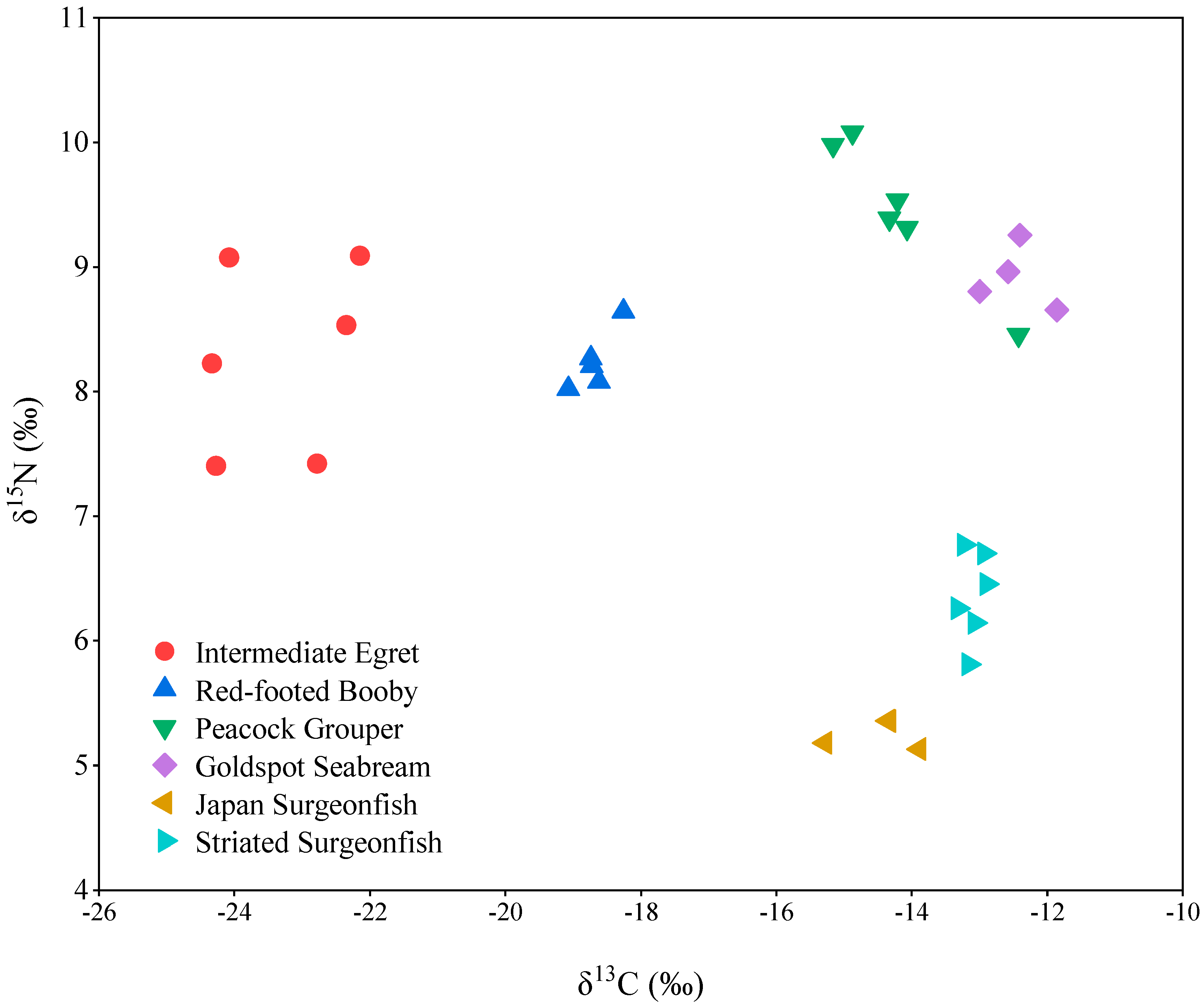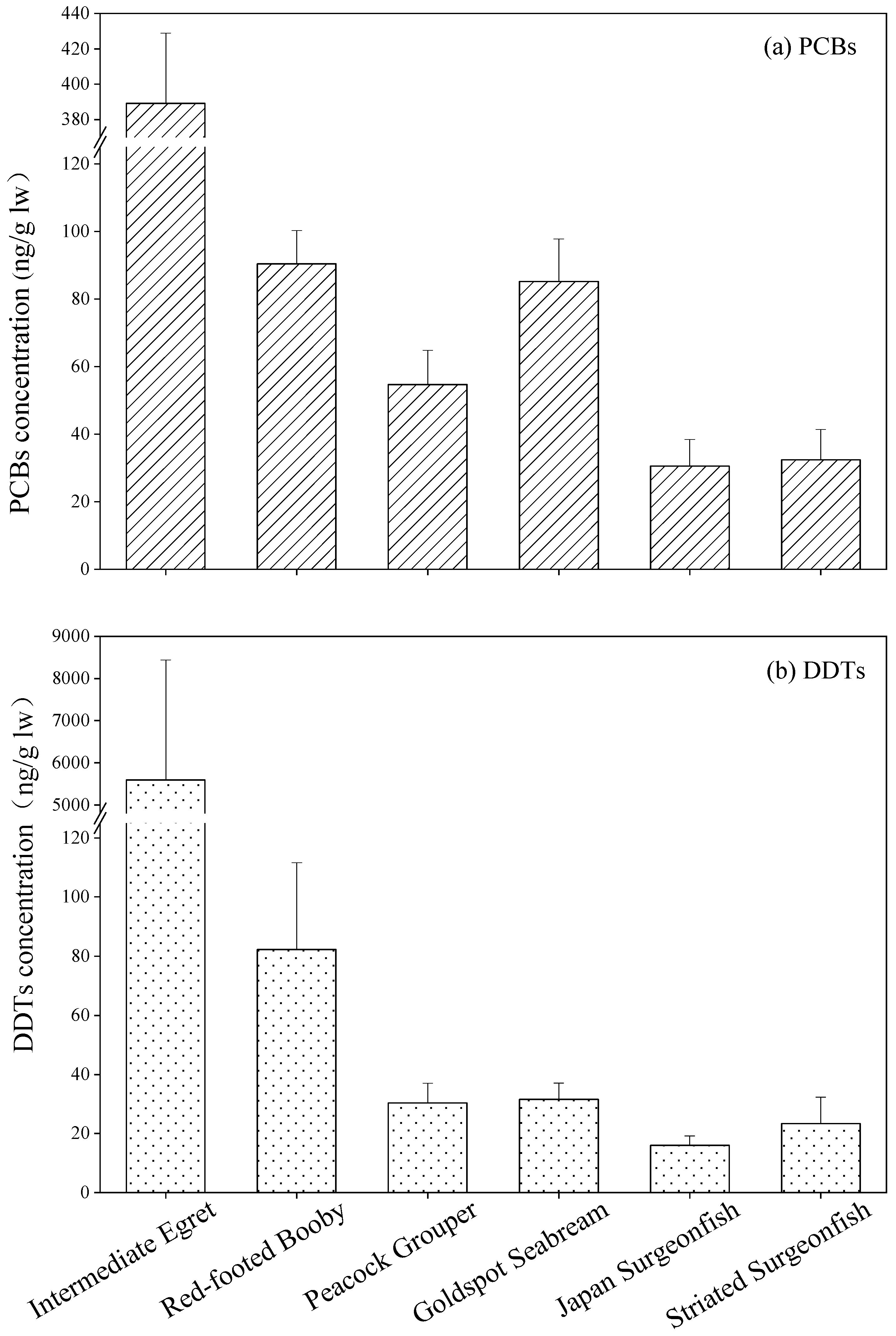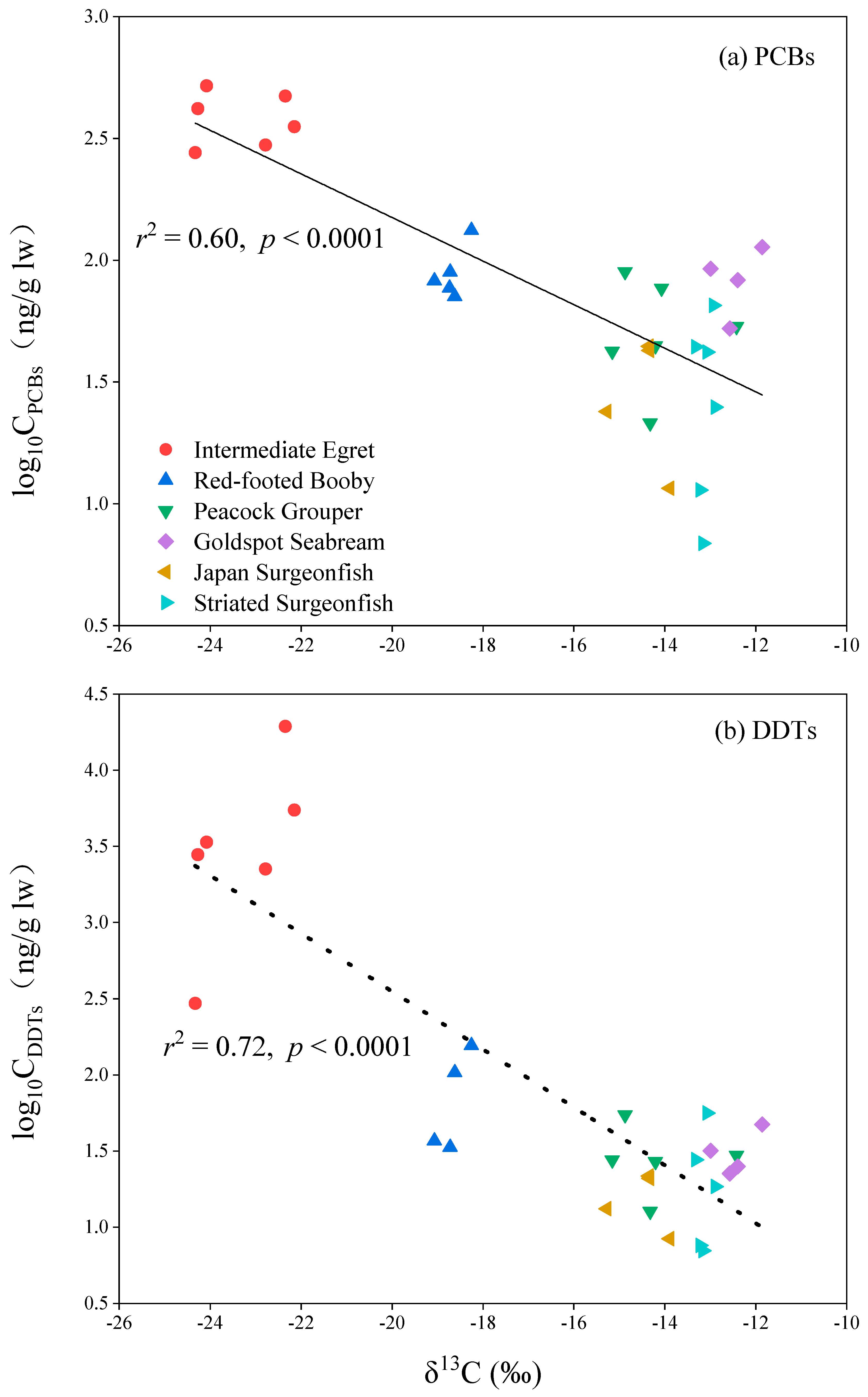Bioaccumulation and Biomagnification of Polychlorinated Biphenyls and Dichlorodiphenyltrichloroethane in Biota from Qilianyu Island, South China Sea
Abstract
:1. Introduction
2. Materials and Methods
2.1. Sample Collection
2.2. Sample Extraction and Analysis
2.3. Quality Assurance and Quality Control (QA/QC)
2.4. Stable Isotope Analysis
2.5. Data Analysis
3. Results and Discussion
3.1. Stable Isotope of δ13C or δ15N in Biota
3.2. Bioaccumulation of PCBs and DDTs in Biota
3.3. Biomagnification of PCBs and DDTs
3.4. Risk Assessment
4. Conclusions
Supplementary Materials
Author Contributions
Funding
Conflicts of Interest
References
- Zhu, M.H.; Yuan, Y.B.; Yin, H.; Guo, Z.Y.; Wei, X.P.; Qi, X.; Liu, H.; Dang, Z. Environmental contamination and human exposure of polychlorinated biphenyls (PCBs) in China: A review. Sci. Total Environ. 2022, 805, 150270. [Google Scholar] [CrossRef] [PubMed]
- Turusov, V.; Rakitsky, V.; Tomatis, L. Dichlorodiphenyltrichloroethane (DDT): Ubiquity, persistence, and risks. Environ. Health Perspect. 2002, 110, 125–128. [Google Scholar] [CrossRef] [PubMed] [Green Version]
- Xing, Y.; Lu, Y.L.; Dawson, R.W.; Shi, Y.J.; Zhang, H.; Wang, T.Y.; Liu, W.B.; Ren, H.C. A spatial temporal assessment of pollution from PCBs in China. Chemosphere 2005, 60, 731–739. [Google Scholar] [CrossRef] [PubMed]
- Guo, Y.; Zhang, B.Z.; Meng, X.Z.; Yu, H.Y.; Ran, Y.; Li, S.M.; Zeng, E.Y. Occurrence and fate of 1-chloro-2,2-bis(4-chlorophenyl) ethene in the environment of the Pearl River Delta, South China. Environ. Sci. Technol. 2009, 43, 3073–3079. [Google Scholar] [CrossRef] [PubMed]
- Zhao, Z.H.; Zhang, L.; Wu, J.L.; Fan, C.X. Residual levels, tissue distribution and risk assessment of organochlorine pesticides (OCPs) in edible fishes from Taihu Lake, China. Environ. Monit. Assess. 2013, 185, 9265–9277. [Google Scholar] [CrossRef] [PubMed]
- Peng, Y.; Wu, J.P.; Luo, X.J.; Zhang, X.W.; Giesy, J.P.; Mai, B.X. Spatial distribution and hazard of halogenated flame retardants and polychlorinated biphenyls to common kingfisher (Alcedo atthis) from a region of South China affected by electronic waste recycling. Environ. Int. 2019, 130, 104952. [Google Scholar] [CrossRef] [PubMed]
- Pan, H.; Geng, J.J.; Qin, Y.K.; Tou, F.Y.; Zhou, J.L.; Liu, M.; Yang, Y. PCBs and OCPs in fish along coastal fisheries in China: Distribution and health risk assessment. Mar. Pollut. Bull. 2016, 111, 483–487. [Google Scholar] [CrossRef] [PubMed]
- Li, Q.L.; Xu, Y.; Li, J.; Pan, X.H.; Liu, X.; Zhang, G. Levels and spatial distribution of gaseous polychlorinated biphenyls and polychlorinated naphthalenes in the air over the northern South China Sea. Atmos. Environ. 2012, 56, 228–235. [Google Scholar] [CrossRef]
- Sun, Y.X.; Hao, Q.; Xu, X.R.; Luo, X.J.; Wang, S.L.; Zhang, Z.W.; Mai, B.X. Persistent organic pollutants in marine fish from Yongxing Island, South China Sea: Levels, composition profiles and human dietary exposure assessment. Chemosphere 2014, 98, 84–90. [Google Scholar] [CrossRef] [PubMed]
- Liu, Y.P.; Li, J.G.; Zhao, Y.F.; Wen, S.; Huang, F.F.; Wu, Y.N. Polybrominated diphenyl ethers (PBDEs) and indicator polychlorinated biphenyls (PCBs) in marine fish from four areas of China. Chemosphere 2011, 83, 168–174. [Google Scholar] [CrossRef] [PubMed]
- Sun, Y.X.; Hu, Y.X.; Zhang, Z.W.; Xu, X.R.; Li, H.X.; Zuo, L.Z.; Zhong, Y.; Sun, H.; Mai, B.X. Halogenated organic pollutants in marine biota from the Xuande Atoll, South China Sea: Levels, biomagnification and dietary exposure. Mar. Pollut. Bull. 2017, 118, 413–419. [Google Scholar] [CrossRef] [PubMed]
- Sun, Y.X.; Hao, Q.; Zheng, X.B.; Luo, X.J.; Zhang, Z.W.; Zhang, Q.; Xu, X.R.; Zou, F.S.; Mai, B.X. PCBs and DDTs in light-vented bulbuls from Guangdong Province, South China: Levels, geographical pattern and risk assessment. Sci. Total Environ. 2014, 490, 815–821. [Google Scholar] [CrossRef]
- Post, D.M. Using stable isotopes to estimate trophic position: Models, methods, and assumptions. Ecology 2002, 83, 703–718. [Google Scholar] [CrossRef]
- Zhu, C.Y.; Sun, Y.X.; Li, D.N.; Zheng, X.B.; Peng, X.Z.; Zhu, T.; Mo, L.; Luo, X.J.; Xu, X.R.; Mai, B.X. Evidence for complex sources of persistent halogenated compounds in birds from the south China sea. Environ. Res. 2020, 185, 109462. [Google Scholar] [CrossRef] [PubMed]
- Drouillard, K.G.; Fernie, K.J.; Smits, J.E.; Bortolotti, G.R.; Bird, D.M.; Norstrom, R.J. Bioaccumulation and toxicokinetics of 42 polychlorinated biphenyl congeners in American kestrels (Falco sparverius). Environ. Toxicol. Chem. 2001, 20, 2514–2522. [Google Scholar] [CrossRef] [PubMed]
- Van den Berg, M.; Birnbaum, L.; Bosveld, A.T.; Brunstrom, B.; Cook, P.; Feeley, M.; Giesy, J.P.; Hanberg, A.; Hasegawa, R.; Kennedy, S.W.; et al. Toxic equivalency factors (TEFs) for PCBs, PCDDs, PCDFs for humans and wildlife. Environ. Health Perspect. 1998, 106, 775–792. [Google Scholar] [CrossRef] [PubMed]
- Chen, D.; Zhang, X.L.; Mai, B.X.; Sun, Q.H.; Song, J.; Luo, X.J.; Zeng, E.Y.; Hale, R.C. Polychlorinated biphenyls and organochlorine pesticides in various bird species from northern China. Environ. Pollut. 2009, 157, 2023–2029. [Google Scholar] [CrossRef] [PubMed]
- Grier, J.W. Ban of DDT and subsequent recovery of reproduction in bald eagles. Science 1982, 218, 1232–1235. [Google Scholar] [CrossRef] [PubMed]
- Bouwman, H.; Yohannes, Y.B.; Nakayama, S.M.M.; Motohira, K.; Ishizuka, M.; Humphries, M.S.; van der Schyff, V.; du Preez, M.; Dinkelmann, A.; Ikenaka, Y. Evidence of impacts from DDT in pelican, cormorant, stork, and egret eggs from KwaZulu-Natal, South Africa. Chemosphere 2019, 225, 647–658. [Google Scholar] [CrossRef] [PubMed]
- Beckvar, N.; Dillon, T.M.; Read, L.B. Approaches for linking whole-body fish tissue residues of mercury or DDT to biological effects thresholds. Environ. Toxicol. Chem. 2005, 24, 2094–2105. [Google Scholar] [CrossRef] [PubMed] [Green Version]





Publisher’s Note: MDPI stays neutral with regard to jurisdictional claims in published maps and institutional affiliations. |
© 2022 by the authors. Licensee MDPI, Basel, Switzerland. This article is an open access article distributed under the terms and conditions of the Creative Commons Attribution (CC BY) license (https://creativecommons.org/licenses/by/4.0/).
Share and Cite
Wang, Q.; Xie, C.; Long, C.; Yang, W.; Wang, Y.; Xu, W.; Zhang, L.; Sun, Y. Bioaccumulation and Biomagnification of Polychlorinated Biphenyls and Dichlorodiphenyltrichloroethane in Biota from Qilianyu Island, South China Sea. Toxics 2022, 10, 324. https://doi.org/10.3390/toxics10060324
Wang Q, Xie C, Long C, Yang W, Wang Y, Xu W, Zhang L, Sun Y. Bioaccumulation and Biomagnification of Polychlorinated Biphenyls and Dichlorodiphenyltrichloroethane in Biota from Qilianyu Island, South China Sea. Toxics. 2022; 10(6):324. https://doi.org/10.3390/toxics10060324
Chicago/Turabian StyleWang, Qingling, Chenmin Xie, Chuyue Long, Weiyan Yang, Yan Wang, Weihai Xu, Li Zhang, and Yuxin Sun. 2022. "Bioaccumulation and Biomagnification of Polychlorinated Biphenyls and Dichlorodiphenyltrichloroethane in Biota from Qilianyu Island, South China Sea" Toxics 10, no. 6: 324. https://doi.org/10.3390/toxics10060324




